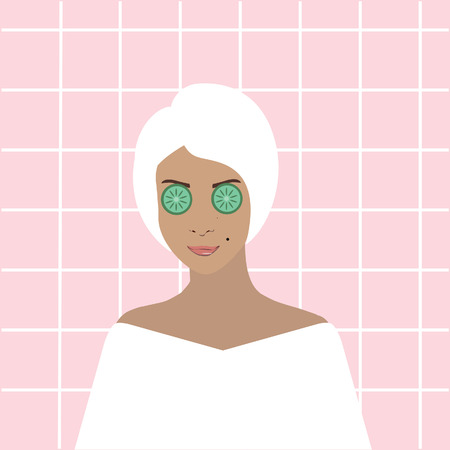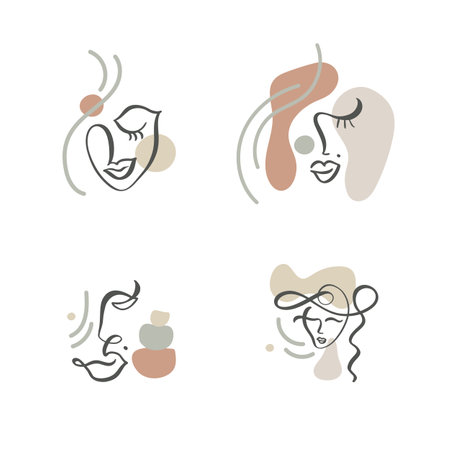Understanding Your Skin Type
Before picking the perfect facial cleanser, its important to know your skin type. Your skin type determines what ingredients and formulas will work best for you. Using the wrong product can lead to dryness, breakouts, or irritation—so getting this step right is key.
Why Skin Type Matters
Facial cleansers are not one-size-fits-all. What works great for oily skin might be too harsh for dry or sensitive skin. Identifying your skin type helps you choose a cleanser that supports your skin’s natural balance instead of disrupting it.
How to Identify Your Skin Type
You can figure out your skin type by observing how your face feels and looks a few hours after washing it with a gentle cleanser and without applying any skincare products.
Common Skin Types
| Skin Type | Key Characteristics | What to Look for in a Cleanser |
|---|---|---|
| Oily | Shiny appearance, especially in the T-zone (forehead, nose, chin), enlarged pores, prone to acne and blackheads | Foaming or gel cleansers that remove excess oil without stripping moisture |
| Dry | Feels tight or flaky, dull appearance, rough texture, may have red patches | Cream-based or hydrating cleansers with moisturizing ingredients like hyaluronic acid or glycerin |
| Combination | Oily in the T-zone but dry or normal on the cheeks; needs targeted care for different areas | Balancing cleansers that remove oil while maintaining hydration where needed |
| Sensitive | Easily irritated, prone to redness, stinging, or burning when using certain products | Gentle, fragrance-free cleansers with soothing ingredients like aloe vera or chamomile |
| Normal | Even tone, smooth texture, not too oily or dry, minimal sensitivity or blemishes | Mild cleansers that maintain the skin’s natural balance without over-cleansing |
Pro Tip:
Your skin type can change with the seasons, age, hormones, or lifestyle habits. Its helpful to reassess it every few months to make sure your skincare routine still fits your needs.
Once you’ve identified your skin type, you’ll be better equipped to find a facial cleanser that keeps your skin clean, healthy, and happy.
2. Types of Facial Cleansers Explained
Choosing the right facial cleanser starts with understanding the different types available. Each kind works best for certain skin types and concerns. Let’s break down the most popular facial cleansers and explore their pros and cons so you can find the perfect match for your skincare routine.
Gel Cleansers
Best for: Oily, acne-prone, or combination skin
Gel cleansers are lightweight and often have a clear consistency. They’re designed to deeply cleanse the skin, removing excess oil and unclogging pores without being too harsh.
Pros:
- Great at removing oil and impurities
- Helps prevent breakouts
- Feels refreshing on the skin
Cons:
- May be too drying for dry or sensitive skin
Cream Cleansers
Best for: Dry or sensitive skin
Cream cleansers are rich and moisturizing. They help clean the skin without stripping away natural oils, making them ideal for those who need hydration.
Pros:
- Nourishing and gentle on the skin
- Smooth texture feels luxurious
- Irritation-free for most sensitive skin types
Cons:
- Might not remove heavy makeup or excess oil effectively
Foam Cleansers
Best for: Normal to oily skin
Foam cleansers start as cream or gel and turn into a foamy lather when mixed with water. Theyre great at lifting dirt and makeup, but can sometimes strip natural oils.
Pros:
- Cleans thoroughly and feels light on the skin
- Easily removes surface grime and leftover products
Cons:
- Might dry out sensitive or dry skin types
Oil-Based Cleansers
Best for: All skin types (especially effective for removing makeup)
This type uses oil to dissolve impurities, including waterproof makeup and sunscreen. Don’t worry—oil cleansers won’t leave your face greasy when used properly.
Pros:
- Dissolves stubborn makeup and SPF easily
Cons:
- Might not feel ideal for already oily skin (though it usually helps long-term)
Micellar Water
Best for: All skin types, especially sensitive or on-the-go users
This no-rinse cleanser uses micelles (tiny cleansing molecules) suspended in soft water to gently lift dirt and makeup from the skin.
Pros:
- No rinsing needed—perfect for travel or quick cleansing
Cons:
Cleansing Balms
Best for: Dry, normal, or mature skin; great for removing makeup at night
Cleansing balms are solid oils that melt into a silky texture upon application. They’re excellent at breaking down makeup while nourishing your skin.
Pros:
Cons:
Cleansers Comparison Table
| Cleansing Type | Main Benefit | Ideal For Skin Type(s) | Main Drawback |
|---|---|---|---|
| Gel Cleanser | Cleans deeply & controls oil | Oily, Combination, Acne-Prone Skin | Might be drying for dry/sensitive skin |
| Cream Cleanser | Nourishes & moisturizes | Dry, Sensitive Skin | Might not remove heavy oil/makeup well |
| Foam Cleanser | Lathers & refreshes | Normal to Oily Skin | Potenially drying if overused |
| Oil-Based Cleanser | Dissolves makeup/oil gently | Able to suit all types (great first cleanse) | Might feel greasy if not rinsed well |
| Micellar Water | No-rinse & gentle cleansing | Sensitive Skin, Travel Use | Might not fully cleanse on its own |
| Cleansing Balm | Nourishing & removes heavy makeup | Mature, Dry, Normal Skin | Takes time to rinse off completely |
Selecting the right cleanser depends on your unique skincare needs. Understanding each type makes it easier to build a routine that keeps your face feeling fresh, balanced, and healthy every day.

3. Ingredients That Matter
When it comes to choosing the right facial cleanser, understanding the ingredients is key. Different skin types and concerns call for different formulations. Whether you’re dealing with acne, dryness, or sensitivity, knowing what to look for (and what to avoid) can make all the difference in your skincare routine.
Common Active Ingredients and Their Benefits
Here’s a breakdown of popular cleanser ingredients and how they match up with specific skin concerns:
| Ingredient | Best For | Why It Works |
|---|---|---|
| Salicylic Acid | Oily & Acne-Prone Skin | Penetrates pores to unclog them and reduce breakouts. |
| Benzoyl Peroxide | Acne-Prone Skin | Kills acne-causing bacteria and helps reduce inflammation. |
| Hyaluronic Acid | Dry & Dehydrated Skin | Attracts moisture to the skin, keeping it plump and hydrated. |
| Ceramides | Sensitive & Dry Skin | Help restore the skin barrier and retain moisture. |
| Glycolic Acid | Dull or Textured Skin | Exfoliates dead skin cells for a brighter complexion. |
| Aloe Vera | Sensitive or Irritated Skin | Soothes redness and calms inflammation. |
Ingredients to Avoid Based on Skin Type
If You Have Sensitive Skin:
- Fragrance: Can cause irritation or allergic reactions.
- Sulfates (like SLS): May strip away natural oils, leading to dryness and discomfort.
- Alcohol: Some types (like denatured alcohol) can be too drying.
If You Have Dry Skin:
- Avoid harsh exfoliants: Physical scrubs can create micro-tears in dry, delicate skin.
- Avoid high-foaming cleansers: These often contain detergents that remove essential oils.
If You Have Oily or Acne-Prone Skin:
- Avoid heavy oils: Ingredients like coconut oil may clog pores for some people.
- Avoid comedogenic ingredients: Look for non-comedogenic labels when possible.
The Bottom Line on Ingredients
Your cleanser should support your skins needs without overdoing it. Think of it as the first step in your skincare routine—a foundation that sets the tone for everything else. By choosing ingredients that match your goals, whether its hydration, exfoliation, or calming irritation, youre setting yourself up for better results down the line.
If youre unsure about certain ingredients or have sensitive skin, always patch test new products before applying them to your entire face. And remember: simpler is often better when it comes to cleansers.
4. Morning vs. Night Cleansing
Your skin has different needs in the morning and at night, which means your cleansing routine should change accordingly. Understanding these differences can help you choose the right facial cleanser for each time of day and get the most out of your skincare.
Why Morning Cleansing Matters
In the morning, your goal is to refresh your skin and remove any sweat, oil, or product residue that built up overnight. Even though you weren’t exposed to dirt or makeup while sleeping, your skin still needs a gentle cleanse to prep it for the day ahead.
What to Look for in a Morning Cleanser
- Gentle formula: You don’t need anything harsh—look for creamy or gel-based cleansers.
- Hydrating ingredients: Since your skin may be drier in the morning, opt for cleansers with glycerin or hyaluronic acid.
- Refreshing feel: Citrus extracts or mint can give your skin a wake-up boost.
Why Night Cleansing Is Essential
Cleansing at night is all about removing makeup, sunscreen, pollution, and excess oil that accumulate throughout the day. Skipping this step can lead to clogged pores and breakouts.
What to Look for in a Night Cleanser
- Deep-cleansing power: Use something that effectively removes buildup without stripping your skin.
- Makeup-removing properties: Consider an oil-based cleanser or double-cleansing method if you wear heavy makeup.
- Nourishing ingredients: Look for calming components like chamomile or green tea to soothe your skin before bed.
Morning vs. Night Cleansing: Quick Comparison
| Morning | Night | |
|---|---|---|
| Main Purpose | Refresh & Prep Skin | Remove Makeup & Impurities |
| Cleanser Type | Mild, Hydrating | Deep-Cleansing or Oil-Based |
| Key Ingredients | Aloe Vera, Glycerin, Citrus Extracts | Charcoal, Salicylic Acid, Chamomile |
| Frequency | Once Every Morning | Every Evening Before Bed |
Tip:
If youre short on time in the morning, consider using micellar water as a quick cleanse before applying moisturizer and SPF. At night, never skip cleansing—even if youre tired! Your skin does most of its repair work while you sleep, so clean skin is a must.
5. Common Cleansing Mistakes to Avoid
Even with the best facial cleanser for your skin type, poor cleansing habits can lead to irritation, dryness, or breakouts. Let’s break down the most common cleansing mistakes and how to fix them so you can keep your skin healthy and glowing.
Using Water Thats Too Hot
Hot water might feel relaxing, but it strips away your skin’s natural oils, leaving it dry and irritated. Instead, stick to lukewarm water—it’s gentle on your skin while still effectively removing dirt and oil.
Over-Washing Your Face
Cleansing more than twice a day can disrupt your skins natural balance. Unless youve been sweating heavily or wearing heavy makeup, washing your face in the morning and evening is enough.
Using the Wrong Cleanser for Your Skin Type
If your cleanser doesn’t match your skin type, it could cause breakouts or excessive dryness. Heres a quick guide:
| Skin Type | Ideal Cleanser Type |
|---|---|
| Oily | Gel-based or foaming cleanser |
| Dry | Cream or lotion-based cleanser |
| Sensitive | Fragrance-free, gentle formula |
| Combination | Balanced pH cleanser or micellar water |
Not Removing Makeup First
Your regular cleanser might not fully remove makeup—especially waterproof products. Use a dedicated makeup remover or micellar water before cleansing to avoid clogged pores and leftover residue.
Rubbing Too Harshly
Your skin isn’t a kitchen counter—go easy on it! Scrubbing aggressively can cause redness and micro-tears. Use your fingertips in gentle circular motions instead.
Skipping Moisturizer After Cleansing
Cleansing can temporarily strip your skin of moisture. Always follow up with a moisturizer suited to your skin type within a few minutes after patting your face dry.
Pro Tip:
Use a clean towel every time you wash your face. Reusing towels can transfer bacteria and oil back onto your skin, undoing all that good cleansing work.
6. How to Build a Complete Cleansing Routine
Creating a complete skincare routine starts with your cleanser, but it doesnt end there. To get the best results for your skin type and lifestyle, its important to pair your facial cleanser with the right steps that support healthy, glowing skin. Heres how to build a full cleansing routine thats easy to follow and actually works.
Step 1: Choose the Right Cleanser for Your Skin Type
Before anything else, make sure youre using a facial cleanser that suits your skin type. Heres a quick refresher:
| Skin Type | Best Cleanser Type | Key Ingredients |
|---|---|---|
| Oily | Foaming or gel cleanser | Salicylic acid, tea tree oil, charcoal |
| Dry | Cream or hydrating cleanser | Hyaluronic acid, glycerin, ceramides |
| Sensitive | Mild or fragrance-free cleanser | Aloe vera, chamomile, oat extract |
| Combination | Balancing or gel-cream cleanser | Lactic acid, niacinamide, green tea |
| Normal | Mild foaming or cream cleanser | Cucumber extract, vitamin E, panthenol |
Step 2: Exfoliate (1–3 Times a Week)
Add exfoliation to your routine a few times per week to remove dead skin cells and boost product absorption. Use physical scrubs if your skin can handle them, or go for chemical exfoliants like AHA/BHA for a gentler option. Don’t overdo it—especially if you have sensitive or dry skin.
Exfoliation Tip by Skin Type:
- Sensitive Skin: Use enzyme-based exfoliants once a week.
- Oily/Acne-Prone Skin: Try salicylic acid 2–3 times per week.
- Mature/Dry Skin: Lactic acid is gentle and hydrating.
Step 3: Hydrate Immediately After Cleansing
Your skin absorbs moisture best when its slightly damp. After patting your face dry with a clean towel (don’t rub!), apply a toner, essence, or serum depending on your needs. Follow with moisturizer to lock in hydration.
Hydration Layering Basics:
- Toner (optional but helpful for balancing pH)
- Treatment serum (target concerns like acne or fine lines)
- Mist (optional for extra hydration)
- A good moisturizer suited to your skin type
Step 4: Customize for Morning vs Night Routines
Your skincare needs may vary throughout the day. In the morning, aim to protect and prep the skin; at night, focus on repair and deep cleansing.
| A.M. Routine | P.M. Routine | |
|---|---|---|
| Cleansing Step | Mild cleanse to remove overnight oils | Double cleanse, especially if wearing makeup/SPF |
| Treatment Focus | Antioxidants (like Vitamin C) | Skin-repairing actives (like retinol or peptides) |
| Main Goal | “Protect” | “Repair” |
Lifestyle Tips for Better Results
- Create consistency: Stick to your routine daily—even when youre tired!
- Tweak seasonally: Use more hydrating products in winter and lighter ones in summer.
- Clean tools regularly: Wash face towels and cleansing brushes weekly to avoid bacteria buildup.
No matter your skin type or schedule, building a thoughtful cleansing routine can make all the difference. Start simple and build up as you learn what works best for you.


